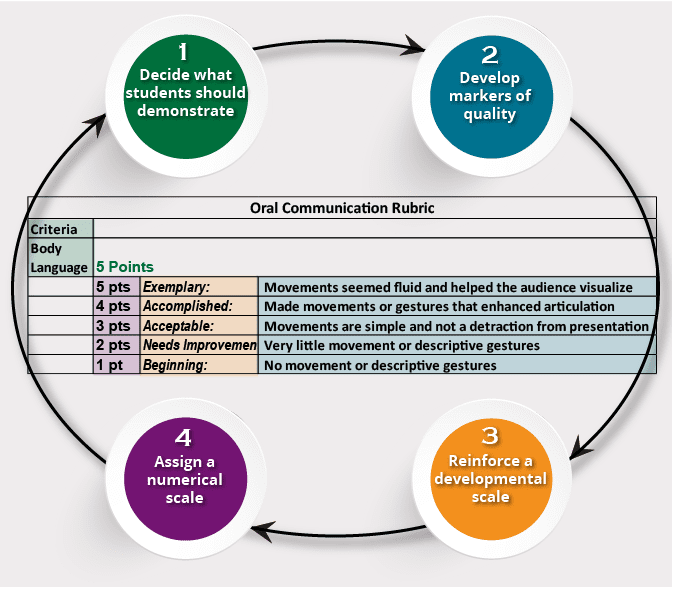Using Rubrics
Why Use Rubics?
Rubrics help instructors:
- Provide clear, direct expectations and components of an assignment to students and TA
- Clarify and provide specific and focused feedback to students to improve learning
- Demystify assignment expectations for students
- Develop consistency in how you evaluate student learning across students and throughout a class
- Reduce time spent on grading; Increase time spent teaching
- Refine teaching skills and course design by evaluating rubric results
Rubrics help students:
- Focus efforts on completing assignments with clearly defined expectations
- Self-reflect and peer-reflect on their learning
- Make informed changes to achieve their desired learning level
How to develop a rubric?

Ask colleagues for rubrics for similar assignments. Begin with one rubric for one assignment in a semester.
- Assignment: Examine an assignment for your course. Select a time insensitive assignment to grade or one that students report as having unclear expectations.
- Criteria: Decide what you want your students to demonstrate about their learning. The criteria or critical attributes must be objectively measurable.
- Quality: Develop markers of quality and add descriptors that qualify each level of performance
- You can also reinforce a developmental scale like Beginning, emerging, exemplary
- You can assign a numerical scale to each level
- Outline objective indicators.
- The criteria must clearly differentiate one performance level from another
- Draft: Give a draft of the rubric to colleagues and/ or TA’s for feedback
- Students: Give students the rubric ahead of time and advise them to use it to guide their assignment. Train students to use your rubric.
- Feedback: solicit feedback from your students to help you judge whether the rubric is clear to them. Identify any weaknesses.
Incorporating rubrics in a course
- Time: Consider how much class time is required for teaching and re-teaching the rubric
- Introducing rubrics
- Provide samples of a complete assignment. Consider asking students for permission to use their work as samples and remove their names
- Have students use the rubric to evaluate sample assignments or peer assignments
- Have students justify their evaluation and explain how they used the rubric
- Have students share their evaluations with the class. Pay attention to their interpretation of the rubric since it may inform rubric adjustments.
- Provide your evaluation of sample assignment and your justification and use of the rubric
Additional Resources:
- Rubric Samples for Higher Education (Kappa Omicron Nu Honor Society)
Find sample rubrics for undergraduate research, student organizations, and reflections. - Rubrics (Berkeley Center for Teaching and Learning)
Learn how to get started with rubrics, how to develop a rubric, and other resources for assessments that use rubrics. - Examples of Rubrics (University of West Florida)
Find rubric examples and templates for evaluating classroom participation, presentations, essays, student papers, thesis, and dissertations. - Value Rubric Development Project (Association of American Colleges & Universities)
Learn how the VALUE (Valid Assessment of Learning in Undergraduate Education) rubrics of AACU contribute to the national dialogue on assessment of college student learning towards LEAP essential learning outcomes. - Rubrics (Michigan State University)
This website provides general resources for building and scoring rubrics. - Assessment 101: So You Want to Develop a Rubric (Campus Labs) This webinar shows how rubrics can assist both facilitators and students alike to better understanding their learning experience. Participants are educated on the different types of rubrics, as well as how to develop a rubric from the ground up.
- Assessing Student Learning with Rubrics (Melissa Wright, Campus Success)
This video breaks down the concept of assessing student learning and discusses the idea of using rubrics as a methodology for assessing student learning outcomes. - Using Rubrics to Assess Student Learning in Higher Education (Patrick Fiorenza, Hezel Associates)
This presentation describes the benefits to using rubrics, strategies to develop a rubric, and case studies from two universities. - A review of Rubric Use in Higher Education (Reddy, Y.M. & Andrade, H., 2010)
This article critically reviews empirical research on the use of rubrics at the post-secondary level, indentifies gaps in the literature, and proposes areas for future research.